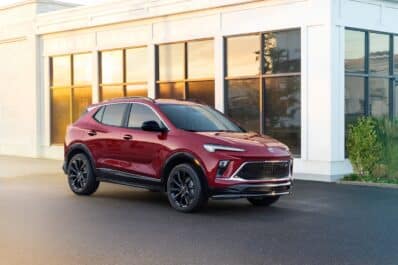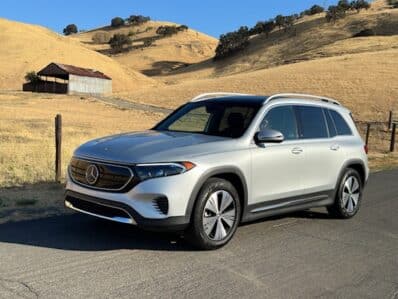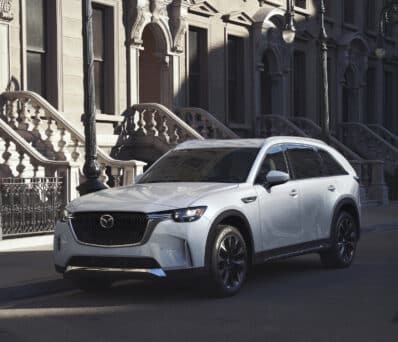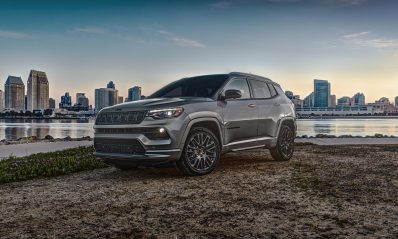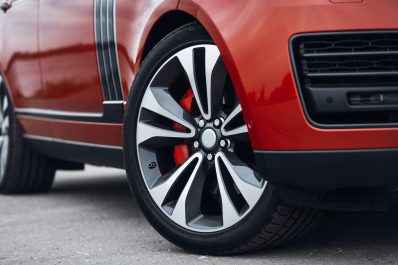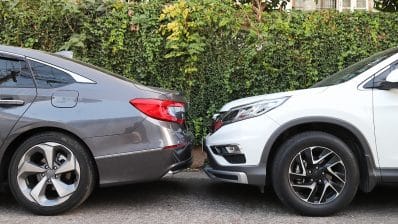“Where’s the trail?” All I could see was a pile of rubble.

During the past 40-plus years, I’ve driven just about everything available and, when it comes to off-roading, tackled some of the most challenging conditions you could imagine, from Moab to the Rubicon Trail. But I had never seen anything quite like the boulder-strewn hillside in California’s Johnson Valley I was now set to transit in the 2022 Ford Bronco Raptor.
Without the spotters helpfully stationed along the way, I’d never have figured out that there even was a trail — albeit one that required my Raptor to clamber over knife-sharp rocks and two-foot-tall boulders and, at one point, guide my right wheels up the side of a sheer stone cliff.
I felt almost giddy reaching the far end of the trail, all the more so knowing I’d not blown a tire or ripped off one of the SUV’s flared fenders. But that was to be only one of the many challenges I wound up putting the Raptor through during the course of a very long day. Among other things, the truck would show its stuff on the King of the Hammers desert racing course, as well as proving its capabilities on pavement.
Overview

The Raptor is “the most badass Bronco yet,” according to design chief Paul Wraith. It might seem easy to dismiss that as hyperbole — at least until you climb behind the wheel of the 2022 SUV and put it through its paces at a place like the Johnson Valley Off-Road Vehicle park.
It’s clearly more than just looks. With its twin-turbo 3.0-liter V-6, Raptor readily took on every challenge I could throw at it, from rock crawling to desert racing. And it proved a lot more competent driving on-road, as well.
It’s more than just muscle, of course. The 2022 Ford Raptor gets a wider track, significantly more wheel travel, increased ground clearance and upgrades to its all-wheel-drive system. Add some sophisticated electronic controls that, among other things, let you adjust key vehicle settings with a turn of a dial to maximize your grip on everything from rocks to sand, mud or snow — as well as pavement.

That’s what’s particularly impressive about the new Raptor. “We built it to go highway speed out in the desert dunes,” said Tom Newhart, a program planning specialist. “But we also made it to tackle the most grueling rock crawling conditions you can get into.”
Exterior
You don’t have to look hard to see that the Raptor isn’t your typical Bronco, starting with its fully boxed platform. It’s been stiffened up and, in the case of the new shock towers, delivers significantly more wheel travel than even the current Bronco Badlands edition. It boasts a ground clearance of 13.1 inches, nearly 5 inches more than a base Bronco. The new Raptor also measures 9.8 inches wider and, at 73.6 inches, it adds another 8.6 inches of track under those aggressive new fender flares. Add to that new 37-inch all-terrain tires.
For serious off-roaders, the Raptor has an astounding approach angle of 47.2 degrees, a breakover angle of 30.8 degrees and a departure angle of 40.5 degrees. It can ford up to 37 inches of water.

While the basic design is familiar, few details were left untouched. Raptor’s grille features the Ford name molded in in big block letters. The LED running lights now glow amber. And the truck gets a new steel bumper with removable end caps and unique tow hooks. The skid plate has been switched to aluminum and extends further under the body to protect the ruggedized drivetrain. Even where Raptor carries over features from the mainstream Bronco — like the disconnecting sway bar, the development team made a number of upgrades to enhance traction under extreme conditions.
Extensive revisions to the underbody and chassis boost torsional rigidity by 50 percent. You get a sense of just how far the development team took things when you check out the additional reinforcements to the tailgate. Beyond the Raptor badges, virtually everything new has a functional purpose. That includes the functional air vents on the sheet-molded compound hood.

And, like every other version of the Bronco, the goal was to make it easy to customize the truck for every occasion, whether taking off the doors or Raptor’s new running boards — which bolt directly into the new rock rails.
Interior
The Raptor is designed to work hard and play hard. It adds high-bolster seats to keep driver and front passenger in their seats, whatever they’re bouncing across. And the digital gauge cluster adds a number of readouts unique to a truck that’s designed for sand and rock. Among other things, you can track roll and pitch.
And there are cameras pointing everywhere, while also providing a 360-degree birds-eye view that proved critical when trying to negotiate narrow trails that could easily rip off one of the SUV’s wide fenders.
Unlike some hard-charging trucks, however, Raptor is designed with creature comfort in mind. At its most basic, the cabin is trimmed in marine-grade vinyl with wash-out flooring. But you can add leather-trimmed neo-suede seats and other niceties like a 10-speaker B&O sound system.

Powertrain
Power comes from a twin-turbo 3.0-liter EcoBoost engine. The engine makes some serious numbers, 418 horsepower and 440 pound-feet of torque, driving through a 10-speed automatic into a three-mode 4×4 system. In the mainstream Bronco line-up, the 3.0-liter EcoBoost maxes out at 400 hp and 415 lb-ft.
Ford clearly took a different approach compared with Raptor’s most direct rival, the Jeep Wrangler Rubicon 392, which relies on a beefy 6.4-liter V-8 pushing out 470 hp and 470 lb-ft. Ford hasn’t published performance numbers, but a very preliminary run would suggest the Bronco Raptor will turn 0-60 numbers on pavement similar to the 4.5-second run Jeep claims for the Rubicon 392.
To handle extreme environments, such as Baja racing, the engine upgrades include both intercooling and a new air-induction system.

When you’re running off pavement, power is only part of the equation, of course. So, much of the drivetrain, as well as the suspension, has gone through major upgrades, starting with larger front and rear driveshafts.
The switch to “competition-level” axles borrowed from Ford’s Bronco DR race trick is accompanied by a unique take on the standard Bronco’s HOSS, or High-Performance Off-Road Stability Suspension. Ford partnered with Fox on the system, which provides Live Valve technology that can adjust each corner to driver input and road conditions “hundreds of times every second.”
Raptors upgraded transfer case also features a 3.06 4×4 LO ratio for up to a 67.7:1 crawl ratio. That and other enhancements means this beast will be able to tow up to 4,500 pounds, 1,000 pounds over the base model.
Safety and Technology
Much of Raptor’s technology is focused on off-roading. Like some of the other Bronco models, it adds features like Trail Control, Trail Turn Assist and Trail One-Pedal Driving. The latter works almost like One-Pedal Driving in an electric vehicle, though limited to low-speed situation. You modulate the throttle, rather than jumping back and forth from throttle to brake, to adjust your speed. Trail Control functions like low-speed cruise control. And Trail Turn Assist locks up one of the rear brakes to allow you to make tight turns on sharp off-road trails.

The 2022 Bronco Raptor also features the SUV’s the now-familiar GOAT Mode selector which lets you dial in the sort of terrain you’re facing — like snow, sand or mud-and-ruts — to configure a broad range of vehicle settings. That covers everything from the Fox shocks to steering input and transmission shifts.
Raptor is available with the latest Sync4 infotainment system with a 12-inch touchscreen. And it features a variety of functions specifically geared for off-road use, including those exterior cameras and the 360-degree view system.
In terms of creature comfort, the Raptor adds a 10-speaker B&O audio package, as well as Adaptive Cruise Control. Other advanced driver assistance systems include forward collision warning with automatic emergency braking, blind-spot monitoring, rear cross-traffic alert and lane-keeping assist.
Driving Impressions

I squeezed in nearly a week’s worth of off-roading in a single, long day out at the Johnson Valley ORV park, and it gave me a clear sense of what the 2022 Bronco Raptor is capable of — pretty much anything I could imagine facing, on-road or off.
The first half of the day was spent traversing a broad mix of sand, rock, gravel and dirt trails. The Raptor’s GOAT mode made easy work of them all, especially when taking advantage of its front and rear locking differentials, as well as those Trail Control, Turn Assist and One-Pedal driving features.
The conventional Bronco is a highly competent machine, especially the Badlands edition, but it would have been a challenge to so easily maneuver the tougher portions of our morning route — and even the Badlands wouldn’t have been capable of dealing with the rock crawl I tackled during the lunch break.
What’s particularly impressive about the Raptor is how easily it adapts from one sort of terrain to another. The afternoon session saw us move to the King of the Hammers, a jarring, high-speed course that can rattle out your fillings and turn a less competent SUV into a smoldering heap of rubble.
While I didn’t have as much time as I’d have liked driving pavement, the Raptor handled the on-road run with equal aplomb. The smart suspension, with its Fox shocks, was far smoother than I might have expected of such a brawny beast. With some serious off-roaders, the penalty comes while driving out to the trailhead. Not so with the Raptor.
2022 Ford Bronco Raptor Specifications
| Dimension | L: 191 inches/W: 86.9 inches/H: 77.8 inches/Wheelbase: 116.5 inches |
| Weight | 3,659 pounds |
| Powertrain | 3.0-liter twin-turbocharged V-6 engine, 10-speed automatic transmission |
| Fuel Economy | 25 mpg city/28 mpg highway/26 mpg combined |
| Performance Specs | 418 horsepower and 440 pound-feet of torque |
| Price | Base price: $69,995; As tested: $82,550 |
| On-Sale Date | Available now |
Wrap Up
Ford’s original Bronco made its debut in 1965 and came close to being called the GOAT — shorthand for Goes Over Any Terrain. As good as it was, it doesn’t compare with the capabilities of today’s Bronco. With features like its GOAT terrain response system, even novices can dial in the right settings to handle some seriously tough conditions.

But the Bronco Raptor takes things to an entirely new level, as I found out crawling over the most challenging rock pile I’ve ever faced.
There are only a handful of vehicles you could even consider a competitor, models like the Jeep Wrangler Rubicon 392 and, perhaps, the Land Rover Defender. If my first drive in the 2022 Ford Raptor is any indication, it’s going to make the competition quite nervous.
The Raptor starts at $69,995, including delivery fees, though it will push to $82,550 fully loaded. And, as with the rest of the Bronco line-up, you’ll have a broad assortment of accessories to choose from. One of the great design features is the ability to quickly bolt on many of those aftermarket features.
The bad news is that the 2022 Raptor is sold out — though you might be able to find one or two around the country if you’re willing to search hard enough. Ford should begin taking orders for the 2023 Bronco Raptor sometime over the summer.
2022 Ford Bronco Raptor — Frequently Asked Questions
How much will the 2022 Bronco Raptor cost?
The Bronco Raptor starts at $69,995 — including delivery fees — more than double the base $30,800 version of the 2022 Ford Bronco. There are hundreds of accessories available for the Raptor that can drive up your final cost substantially.
When can I order a 2022 Ford Bronco Raptor?
If you haven’t placed your order already you’re likely out of luck. You may find one at a dealer if you’re willing to look long and hard. But essentially all have been accounted for. Otherwise, watch for news revealing when Ford will begin taking orders for the 2023 model year Raptor.
What powers the 2022 Ford Bronco Raptor and how much power does it make?
The 2022 Ford Bronco Raptor draws power from a twin-turbocharged 3.0-liter V-6. It makes 418 horsepower and 440 pound-feet of torque.





